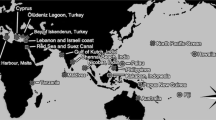Abstract
The chamber is a simple device which makes it possible to hold copepods of length range between 1 and 15 mm or other bilateral animals of similar size for visual examination, sketching or dissection. The chamber consists of four parts: a base (a standard slide); the chamber proper which is a cylindrical cavity 16 mm in diameter cut into a rectangular (or square), transparent, 3 mm thick perspex (plexiglass) plate whose maximum width is the same as the width of the base; one or more lengths of thin synthetic (nylon) threads; and a standard coverglass. The perspex plate (the chamber proper) is attached to the base (slide) using a thin coat of plasticine (or any suitable dense lubricant) applied to the bottom surface of the plate. One or several nylon threads are set in the plasticine coat and cross the plate and its cavity. The ends of threads are outside the plate; one end of each thread is fixed, and one is left free. The chamber is filled with a suitable liquid medium, the specimen is placed in the desired position beneath the thread(s) and its position is fixed by pulling the free end of thread(s) so that the thread(s) press slightly against the specimen, holding it to the surface of the slide. The chamber then is covered with the coverglass.
Similar content being viewed by others
Author information
Authors and Affiliations
Rights and permissions
About this article
Cite this article
Heptner, M.V. New chamber for holding and sketching copepods and other small zoological specimens. Hydrobiologia 417, 121–124 (2000). https://doi.org/10.1023/A:1003867724176
Issue Date:
DOI: https://doi.org/10.1023/A:1003867724176




